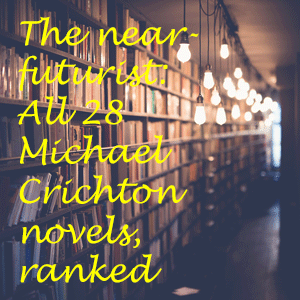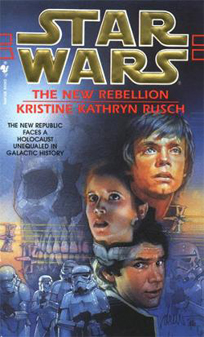As Bantam navigated its way through the post-“Return of the Jedi” timeline in the 1990s, not every writer they hired turned out to be a Zahn or a Stackpole. Some of them were one-and-done. The problem for readers is that we had to experience the one awful book before the writer was dropped. Kristine Kathryn Rusch is one of those one-and-dones, and her “The New Rebellion”(1996) earns a spot on the short list of worst “Star Wars” novels.
“The New Rebellion” has some apologists, and I admit that Rusch would be a decent young-adult writer in the vein of Kevin J. Anderson or Dave Wolverton, who both switched from the adult “Star Wars” series to YA titles. “New Rebellion” has the YA traits of convenient plots (sabotaged droids from one factory somehow become a galactic threat), broad characterization (Leia is totally off her game as Chief of State, even resorting to political gamesmanship) and lots of callbacks to the movies (EV-9D9-2, basically the same as the torture droid from Jabba’s palace, pops up here). Still, even the argument that Rusch’s book should’ve gotten the YA label doesn’t change the fact that it’s awful.
To cite a few cringeworthy moments:
- Communication around the galaxy is instantaneous in this book. Leia is able to communicate from the Senate building on Coruscant to Luke’s X-wing, which is en route through hyperspace! Previous books had established galactic communications as being somewhat like email, not like an instant phone conversation. I can see why the editors couldn’t easily fix this issue, because villain Kueller’s plot requires instantaneous remote detonations of booby-trapped droids all over the galaxy.
- But other things should’ve been fixed. Corellia is misspelled “Correllia” on every reference.
- Cole Fardreamer discovers the secret bombs in the X-wings because they have Imperial logos on them. The only way this could’ve been more ridiculous is if they had said “BOMB” on them.
- Leia notes that she never trusted Lando ever since Cloud City, and Han also expresses doubts about his long-time friend. This contradicts every novel written before this, not to mention “Return of the Jedi.”
- Wedge doesn’t know Talon Karrde or his ship, the Wild Karrde, in this novel. This contradicts one of the “X-wing” novels, not to mention common sense, as Wedge and Karrde moved in the same circles for many years before this. Also, characters regularly call Karrde by his first name, Talon, which doesn’t jibe with Zahn’s and Stackpole’s works.
- Lando and Han go to the dangerous Smuggler’s Run to follow up on a lead (even though phone-style communication is instantaneous? But I digress …). The villain in Smuggler’s Run, Nandreeson, seems to exist solely to wait for Lando to arrive so he can torture and kill him.
- Rusch refers to Palpatine as being a senator when he took over the government and declared himself emperor. While it’s true that the prequels hadn’t come out yet when “New Rebellion” was written, the opening page of the “A New Hope” novelization gives an overview of the prequel plot, and it notes that Palpatine was president at the time he declared himself emperor. Of course, “president” became “supreme chancellor” in the movies, but still, it’s quite clear he wasn’t a mere senator.
- And here’s the ultimate forehead-smacker: Han and Leia send their kids to “safety” on Anoth, the exact same planet Anakin was kidnapped from in the “Jedi Academy Trilogy.”
Then there are problems of omission:

- The book that takes place just before this, “Tyrant’s Test” (the final volume of the “Black Fleet Crisis”), chronicles an Imperial, Major Sorranan, who takes off for the Core with the Yevetha’s entire Black Fleet. He’s not heard from in this book (or any future book, for that matter), even though it would’ve helped Rusch’s story if Sorranan had teamed up with Kueller. As it stands, Kueller has the Force, and a substantial army of droids and ships that he got from … well, it’s never explained. While “The New Rebellion” was written simultaneously with “The Black Fleet Crisis,” good communication among the editing team could’ve provided a neat tie-in between novels.
- I’m not going to complain about the clichéd nature of the all-powerful Kueller, because Rusch (probably by accident) demonstrates that he enhanced his dark-side power the same way Anakin did in “Episode III”: By killing loads of people. So it works, barely. Nor am I going to complain about Kueller’s demand that Leia turn the New Republic over to him (what a simplistic view of how governments work), because ultimately he just wants to kill Luke and Leia, which makes tactical sense in terms of a power play. What I am going to complain about is that Luke’s new Jedi Knights are nowhere to be found in fighting this galaxy-threatening dark-sider! “Black Fleet Crisis” had the same inexplicable omission, but it’s more glaring here since the villain is one of Luke’s fallen students.
- And that brings me to another missed opportunity. Kueller and his apprentice, Brakiss, are Rusch’s inventions for this book. It would’ve been cool for fans if she had used a couple of Jedis or Dark Jedis from previous books and comics. (Michael Stackpole later retconned Brakiss into the “Jedi Academy” timeframe via “I, Jedi.”) For example, Lumiya and Flint from the Marvel comics were available at this point (Both would have their stories fleshed out in later writings).
“The New Rebellion” has a couple kinda OK elements. Some of Han’s old friends whom A.C. Crispin would incorporate into the “Han Solo Trilogy” are invented in “New Rebellion.” And I have to say that Rusch is pretty good at writing R2-D2 and C-3PO (and Cole seems like one of the droids’ random short-term owners). So if you’re a die-hard fan of the “Droids” TV series and comics, you’ll find some decent prose about the duo here.
Other than that, unless you are an absolute completest, there’s no good reason to read “The New Rebellion” and plenty of reasons to skip it.

